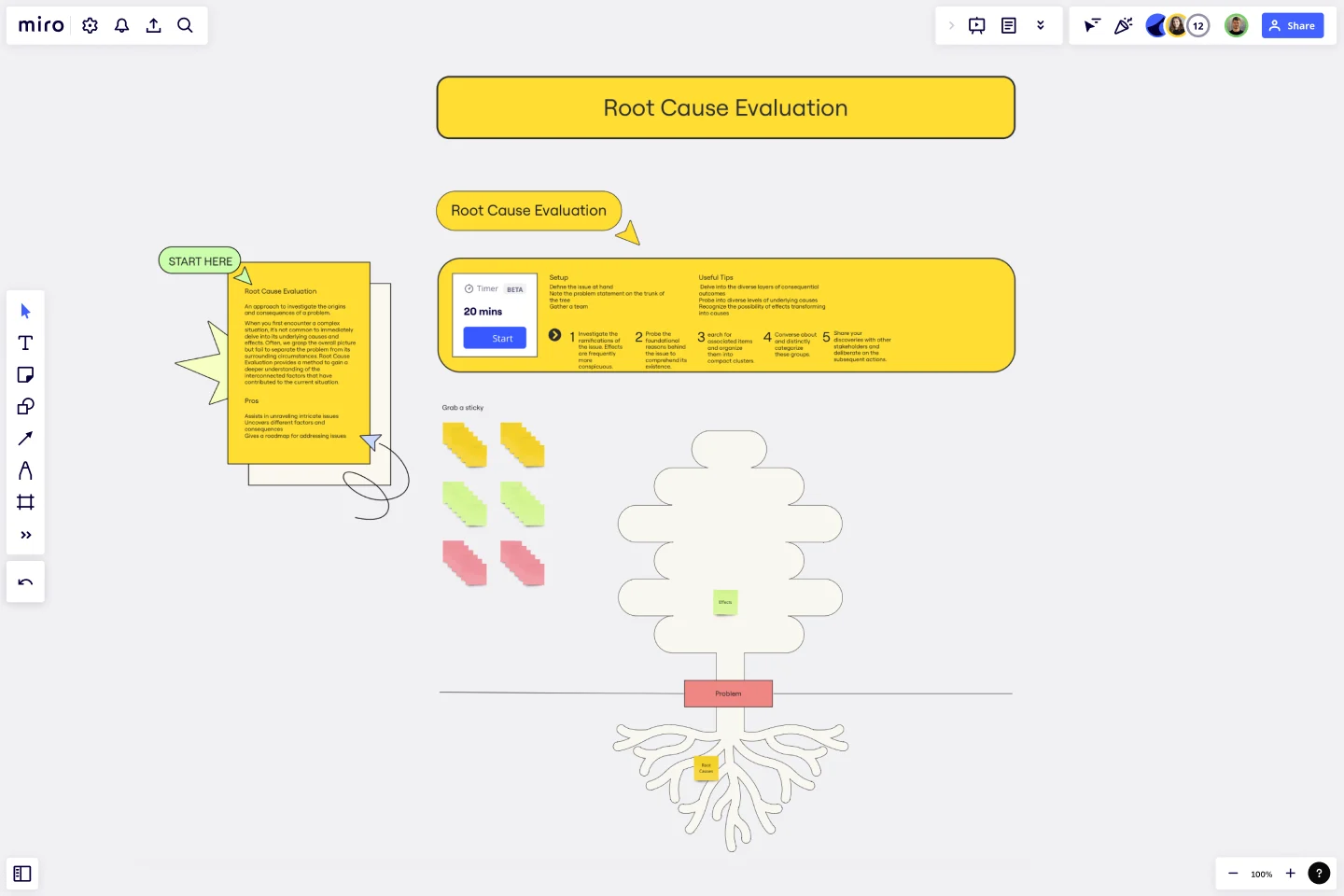Root Cause Evaluation Template
Investigate the origins and consequences of a problem with the Root Cause Evaluation Template.
About the Root Cause Evaluation Template
When we encounter a complex situation, it's common to have a general understanding of what's going on, but it can be challenging to identify the root cause of the problem. We may see the symptoms of the issue, but we fail to separate the problem from its surrounding circumstances. This is where the Root Cause Evaluation Template comes in.
By analyzing the underlying causes and effects, we can identify the root cause of the problem and develop effective solutions to address it. Root Cause Evaluation involves asking questions, gathering data, and analyzing the information to identify the underlying causes of the problem. It's a valuable tool for problem-solving and decision-making in various fields, including business, healthcare, and engineering.
Benefits of using the template
Assist in unraveling complex issues.
Uncover different factors and consequences.
Give a roadmap for addressing issues.
How to use the template in Miro
Investigate the ramifications of the issue. Effects are frequently more conspicuous.
Probe the foundational reasons behind the issue to comprehend its existence.
Search for associated items and organize them into compact clusters.
Converse about and distinctly categorize these groups.
Share your discoveries with other stakeholders and deliberate on the subsequent actions.
Setup
Define the issue at hand.
Note the problem statement on the trunk of the tree.
Gather a team.
Useful tips
Delve into the diverse layers of consequential outcomes.
Probe into diverse levels of underlying causes.
Recognize the possibility of effects transforming into causes.
Get started with this template right now.
Card Sorting Template
Works best for:
Desk Research, UX Design, Brainstorming
Card sorting is a brainstorming technique typically used by design teams but applicable to any brainstorm or team. The method is designed to facilitate more efficient and creative brainstorms. In a card sorting exercise, you and your team create groups out of content, objects, or ideas. You begin by labeling a deck of cards with information related to the topic of the brainstorm. Working as a group or individuals, you then sort the cards in a way that makes sense to you, then label each group with a short description. Card sorting allows you to form unexpected but meaningful connections between ideas.
SUS Evaluation
Works best for:
Design, UX
To assess the emotional experience of users, use the SUS Evaluation Template. This involves conducting a survey with a set of questions where respondents rate their level of agreement on a scale ranging from 'Strongly Disagree' to 'Strongly Agree.' These questions evaluate various aspects of the user experience, such as ease of use, aesthetics, and overall satisfaction. This approach is valuable for comparing design iterations and evaluating the effectiveness of products and services.
Product Development Roadmap Template
Works best for:
Product Management, Software Development
Product development roadmaps cover everything your team needs to achieve when delivering a product from concept to market launch. Your product development roadmap is also a team alignment tool that offers guidance and leadership to help your team focus on balancing product innovation and meeting your customer’s needs. Investing time in creating a roadmap focused on your product development phases helps your team communicate a vision to business leaders, designers, developers, project managers, marketers, and anyone else who influences meeting team goals.
Storyboard for Video Production Template
Works best for:
Storyboard
The Storyboard for Video Production template is your go-to tool for planning every shot of your video project. Outline scenes, dialogues, camera angles, and visual elements to create a coherent narrative. Perfect for filmmakers, educators, or content creators, this template ensures that every aspect of your video aligns with your creative vision, streamlining production and enhancing the overall quality and impact of your project.
User Story Map Template
Works best for:
Marketing, Desk Research, Mapping
Popularized by Jeff Patton in 2005, the user story mapping technique is an agile way to manage product backlogs. Whether you’re working alone or with a product team, you can leverage user story mapping to plan product releases. User story maps help teams stay focused on the business value and release features that customers care about. The framework helps to get a shared understanding for the cross-functional team of what needs to be done to satisfy customers' needs.
Service Definition Canvas
Works best for:
Research & Design
The Service Definition Canvas helps you define and visualize the core components of your service. This template is perfect for outlining service interactions, identifying improvement areas, and aligning teams. Use it to create a clear and comprehensive service blueprint that enhances customer experience and operational efficiency. It's ideal for strategic planning and ensuring a cohesive understanding of service delivery among stakeholders.
